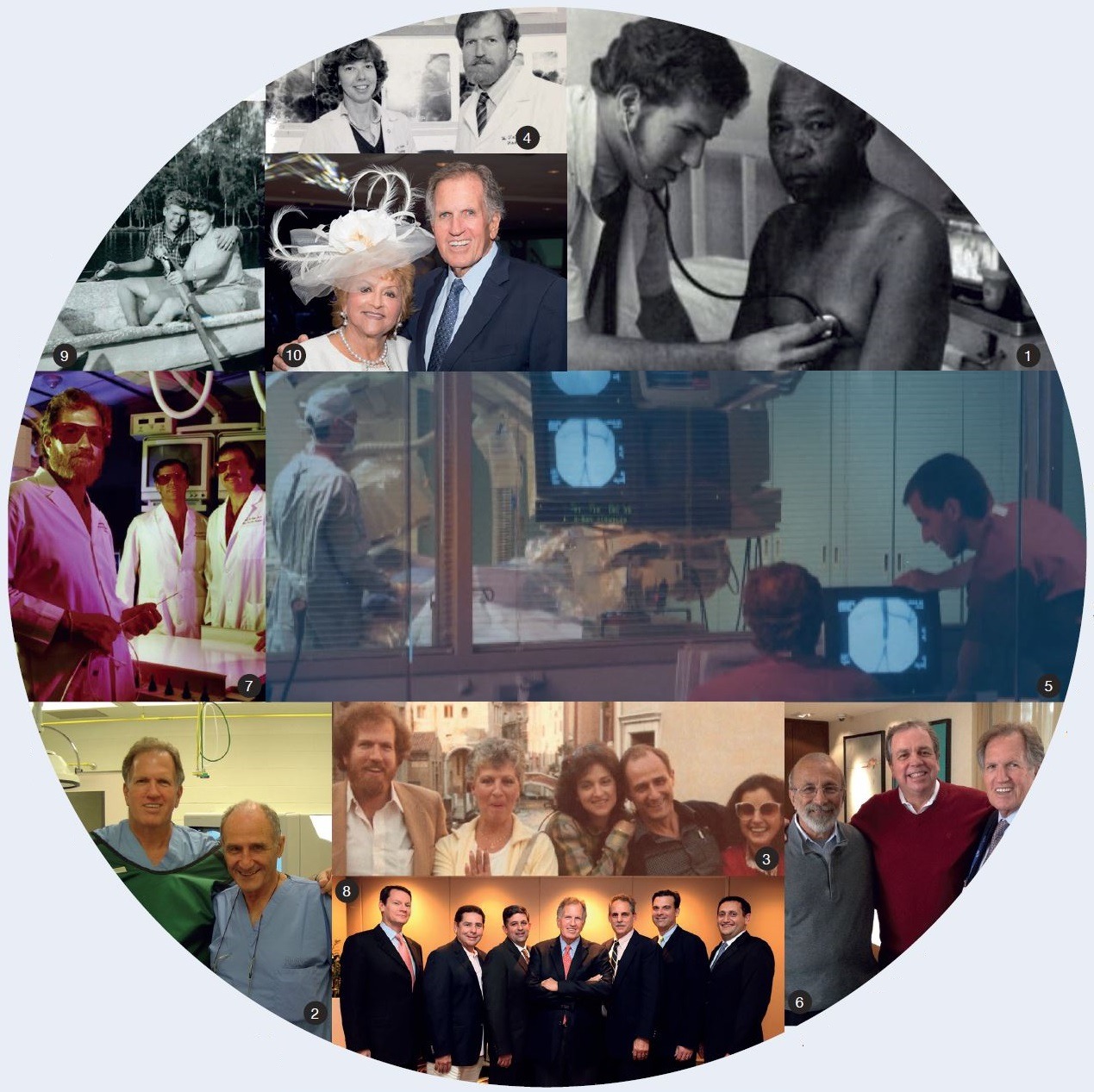
Katzen, a pioneer, thought leader and innovator, delivered the plenary lecture titled “My life in interventional radiology” at the 2018 Asia Pacific Society of Cardiovascular and Interventional Radiology meeting (APSCVIR; 8–11 March, Auckland, New Zealand).
“Interventional radiology in the USA has become a true and defined discipline of medicine and there are no limits to where our imaginations can take us, as long as we remain focused on improving the status quo and making changes to improve patient care,” Katzen said.
Tracing the beginning of interventional radiology with Charles Dotter’s first therapeutic use of the catheter in 1964, followed by his description of balloon angioplasty as a new technique, Katzen noted that it was in the decade after, i.e. in the 70s, that Katzen himself finished medical school, an internship in internal medicine and completed his radiology residency. “There was no CT, ultrasound, or cross-sectional imaging. Angiography was the ‘definitive’ diagnostic test, short of sugery, and exploratory laparotomy was the most common procedure. People were leaning more and more about how to navigate the body with what would today be considered very primitive tools. Interventional radiology did not exist; fellowships were few, but available in ‘angiography’ or ‘cardiovascular radiology’,” he said, commenting to Interventional News that “there was clearly a lot of room to improve healthcare”.
Katzen also showed a picture that is important to him, even today (photo 1). “One thing that I learnt as a medical student holds true to this day: the answer is always at the bedside. In this era of high-tech medicine when people cannot think without a CT scan, it shows that it is the patient who has the answer, hidden within him/her. So being close to the patient and listening to the patient can be extraordinarily revealing,” he said.
In an era when it was atypical for radiologists to actively seek patient contact, while other radiology residents used to moonlight doing extra radiology work, Katzen used to moonlight doing house calls by covering for general practitioners. “This led to my belief in ‘high-tech, yet high touch’ care in which patient contact is central,” Katzen said. Rejuvenated in Rome Life did not always go as Katzen envisaged and before his fellowship, he was turned down for a job in private practice that he applied for due to lack of experience. However, this led to other opportunities and Katzen went on to do a fellowship in cardiovascular radiology and carried on in academic practice in New York. This in turn, led to a fellowship in Rome, Italy, with the technically brilliant Plinio Rossi (photo 2), who had recently left St Vincent’s Medical Center in New York to return to Italy after building one of the largest angiographic departments in the USA.
“In 1974, I started in July at St Vincent’s Hospital and Medical Center as a fellow who was in line to become the next section chief. In September, I left for Rome for a three-month ‘fellowship’. This decision was perhaps the single most impactful event in my professional life, because I learnt from Plinio Rossi, a truly unique individual, not just technical skills but also his respect for tissue. We did several procedures together that were firsts and it was at this time that I embraced using the catheter as a surgical instrument,” described Katzen. It was also in that warm Roman Autumn (photo 3) that Katzen lost his fear of the unknown “as I understood that all progress needed to be driven by improving patient care and outcomes. I also met Andreas Gruentzig who later became the first person to successfully use balloon angioplasty in the coronary arteries. Gruentzig’s success resulted in a transformative technology, but his dream, which was the catheter-based percutaneous treatment of vascular disease in alert, awake patients was equally thought-provoking. Here was an internist who was also an interventionalist, and I began to think, I too, could be a radiologist/proceduralist who was a clinician,” explained Katzen.
Time in the Italian capital yielded another valuable insight with Katzen mulling on the idea of a practice model that would “serve as a base for the rest of my career. I returned to New York a different person; the ‘passion’ had found a purpose,” he said.
The Alexandria years
On his return to the USA, Katzen left New York and began working as a radiologist at the Alexandria Hospital in Virginia with Arina van Breda (photo 4) as his partner. Almost at once, he began advocating clinical practice for interventional radiology. He also rapidly expanded his practice to full-time interventional radiology. The establishment of the non-invasive vascular lab saw Katzen perform his first balloon angioplasty in 1974 and a series of US firsts including the first renal angioplasty. He also wrote and published on the use of embolization to stop bleeding and he also wrote the first text book on interventional radiology in 1980 that revealed the broad scope of the discipline.
Katzen also established a fellowship training programme and developed a sense of urgency around training radiologists ‘quickly’ (photo 5). This naturally led to beginning live case education which started off as tutorials in angioplasty, once per month. Interest in teaching people and disseminating the message of less invasive medicine also led Katzen to pioneer the use of sophisticated video and audio technology to enhance the process of education for practitioners.
He is also credited with being the first to use “live patient demonstrations” in the USA, which became the benchmark for procedural education in endovascular therapy, and many other procedural areas of medicine. Jeffrey L. Rodengen author of The Ship in the Balloon: The Story of Boston Scientific and the Development of Less-Invasive Medicine writes: “Gruentzig’s demonstration style was adopted and championed by Barry Katzen. John Abele, founder of Boston Scientific, who participated in many of these courses is quoted as saying: ‘It was really a revolution in education. Doctors would fight to get to these courses and watch these live cases. The video would zoom in and let them seen things they could not see even when they were in the operating room. And it was no-holds barred: the good and the bad were shown, and that has really changed the face of medicine.’” Katzen received a lifetime achievement award from Transcatheter Cardiovascular Therapeutics (TCT) in 2007 for originating live case teaching.
In the late 80s interventional radiology had gained significant ground by providing alternatives to surgery in many different conditions. In parallel was the development of interventional radiology practice and the demand for acknowledgement that the interventional radiologists needed to be equal partners in patient care, a viewpoint that Michael Dake, a close colleague and Ernie Ring, a longtime friend shared with Katzen (photo 6).
Katzen was prescient at predicting turf battles that could lead to the demise of radiology involvement in endovascular procedures without clinical practice. This was all driven by the disruptive technology of transluminal balloon angioplasty.
“As-yet turf was not an issue because surgeons simply saw angioplasty as ‘mickey mouse’ care, without real benefit, but I could see that we were headed on a collision course between different disciplines. It was not just proceduralists, we would soon be using the same technique to treat the same disease everywhere in the body. However, different specialties would be doing so and nobody was really talking to each other,” he said. Therefore, Katzen reasoned multidisciplinary models, and patient-centred care needed to be approached as an alternative practice method. During this time he also developed a ‘white paper’ on building an integrated institute based on a collaborative organisational model.
The Miami years
In 1986, Katzen left a well-established programme at Virginia to create something new, which was not possible in Alexandria. “I had bold ideas of integrated care with interventional radiology at the centre of clinical care, and as an equal clinical partner in care. The new organisational model was based on collaboration and mutual benefit, rather than traditional silos and had at its heart, the advancement of less-invasive medicine. It was also built on a philosophy of teamwork.” (Photo 8)
In the first year at Miami, Katzen focused on clinical work, building bridges and getting multidisciplinary support. In the second year, he began a new educational programme with live cases that ultimately expanded into the International Symposium on Endovascular Therapy (ISET).
Innovations during this time saw the expanding of the definitions of image-guided therapy including accessing a beating heart in the angiosuite, but procedures were getting more complex and further change was was called for. Galvanised by the idea of changing the definition of the angiosuite, in 2008, Katzen and his team developed an expansion strategy to create optimal planning and support for the future of image-guided therapies. Fundamental to the plan was that inclusivity leads to resources. Since then, developments at MCVI have included a US$120 million expansion project that has seen the building of interventional suites of the future: there are two new endovascular suites that have glass walls and a video system allowing people to sit in a theatre-style chair outside of the suite and control what they are watching using an iPad. “It is all about being open, transparent and practicing in the sunshine. Fittingly, in many cases, it is well-known patients who have been very generous in their philanthropy and fundraising efforts.”
Katzen acknowledged the vital role played by Judith Katzen, noting that his lifetime partner who has shared his journey (and love of boats) since they were in high school is the secret of his success (photos 9 and 10). “I have been part of, and witness to one of the greatest movements in medical history: the move towards less invasive therapy, to which I have a lifelong commitment. Right from its early beginnings, from seemingly minor procedures, there were big concepts that have changed the landscape of medicine,” Katzen concluded.
Katzen’s principles of success
- Integrity is the key
- Be an instrument of change rather than a victim of it
- Never be satisfied with the status quo: continually try to improve care for our patients
- No one can go it on their own: engage and involve others, and create ‘win-win’ situations and outcomes
- A vision without execution is a hallucination, you need to do the work to makes things happen
- Know your own strengths and weaknesses, because sure as sure can be, everyone else will
- I have a lifelong commitment to less-invasive therapy











…well written piece accurately describes a ‘golden era’,__the evolution of Interventional Radiology and the clear leadership of Barry Katzen(always accessible).
Notable is his praise and selfless acknowledgement of predecessors and contemporaries.
Especially endearing is his description of his relationship with Plinio Rossi,a mentor in N.Y.and in Rome;_truly a ‘giant’ in the growth of angiography/interventional radiology.
A clear record,a required historical content presented within the character of an extraordinary biographical experience.
Well done,__inspiring.